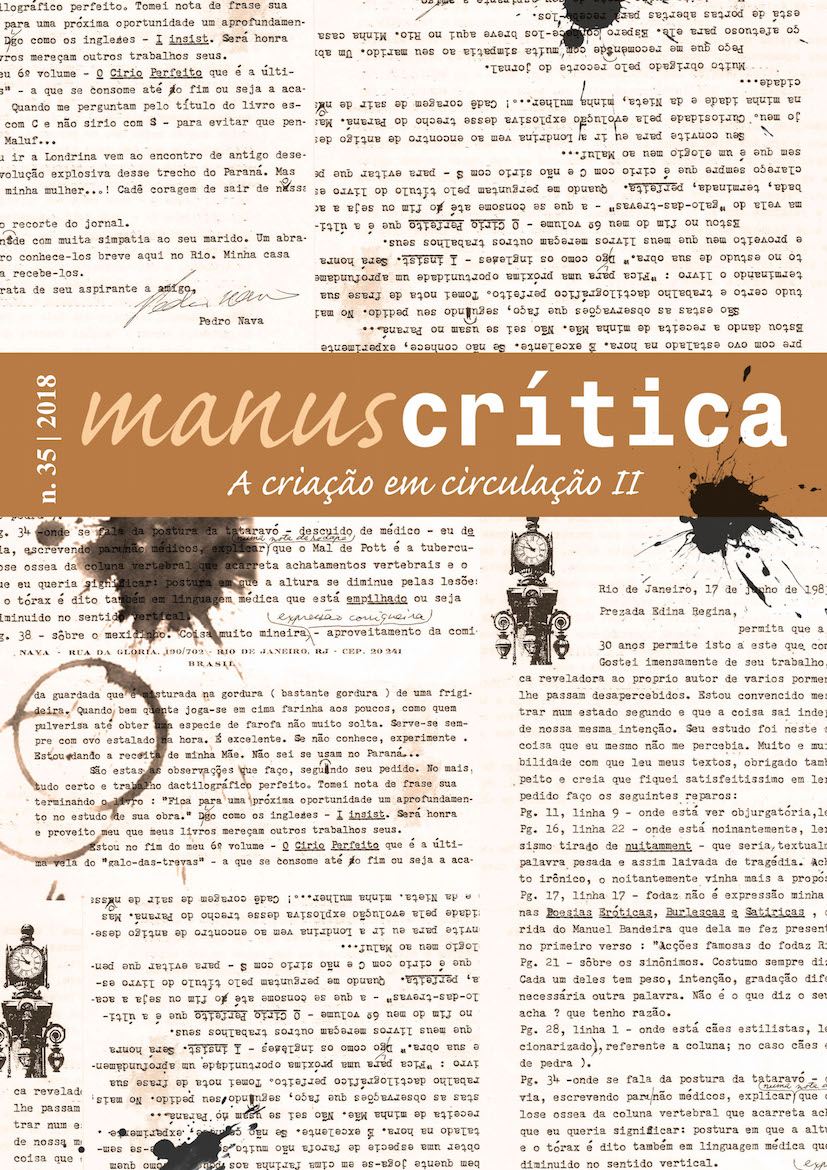The unknown figure in Chronicle of the murdered house and its representations in the fictional manuscripts "Betty's Diary" and "André's Diary"
DOI:
https://doi.org/10.11606/issn.2596-2477.i35p165-181Keywords:
fictional manuscript, genetic criticism, Chronicle of the Murdered House, Lúcio Cardoso, creative processAbstract
This paper aims to investigate both the creation process and the representation of a unknown figure present in the novel named Chronicle of the murdered house, published in 1959 by Lúcio Cardoso. In the book’s structural fictional level this figure is responsible for rescuing and collecting a variety of manuscripts left by ten first-person narrators as they rearrange them in order to orchestrate the narrative voices that composes the novel. These narrative can be seen as some sort of “fictional manuscripts” – which is an expression employed by Julio Castañon Guimaraes who realized the text establishment of the critical edition of the novel – since they are compounded by letters, diaries, testimonies, memoir and narratives. Anonymous and with no voice, the hidden figure leaves two types of marks in the fictional manuscripts: not only there omitted parts indicated by dots but also the notations that point to the material conditions of the work (as it is indicated by “written in the margin…”). In the light of the analytical methodology of the Genetic Criticism, this text is interested in discussing the representation of this hidden figure both in Betty’s Diary and André’s Diary. In other words, it seems for me that the notations that point to the material aspect of the fictional manuscripts, as well as the significations that the written in the margin evoke in the readers and in the novel’ structure.
Downloads
References
ALBERGARIA, Consuelo. Espaço e transgressão. In: Crônica da casa assassinada. 2ª. ed. Edição crítica coordenada por Mário Carelli. (Coleção Archivos, nº 18). Madrid, Paris, México, Buenos Aires, São Paulo, Rio de Janeiro; Lima: ALLCA XX / Edusp, 1996, p. 681-688.
BANDEIRA, Manuel. Lúcio Cardoso. Folha de São Paulo, São Paulo, 3 dez. 1960. Folha Ilustrada, Efemérides, p. 2. Disponível em: http://acervo.folha.uol.com.br/fsp/1960/12/03/21//4498698. Acesso: 19 out 2018.
CARDOSO, Elizabeth. Feminilidade e transgressão: uma leitura da prosa de Lúcio Cardoso. São Paulo: Humanitas / Fapesp, 2013.
CARDOSO, Lúcio. Crônica da casa assassinada. Edição crítica coordenada por Mario Carelli. 2ª ed. (Coleção Archivos, n. 18). Madrid, Paris, México, Buenos Aires, São Paulo, Rio de Janeiro, Lima: ALLCA XX / Edusp, 1996.
CARDOSO, Lúcio. Diários. Organização, apresentação, cronologia, estabelecimento de texto e notas por Ésio Macedo Ribeiro. Rio de Janeiro: Civilização Brasileira, 2012.
CARELLI, Mario. Crônica da casa assassinada: a consumação romanesca. In: Crônica da casa assassinada. 2ª. ed. Edição crítica coordenada por Mário Carelli. (Coleção Archivos, nº 18). Madrid, Paris, México, Buenos Aires, São Paulo, Rio de Janeiro; Lima: ALLCA XX / Edusp, 1996, p. 625-639.
GUIMARÃES, Júlio Castañon. Nota filológica: procedimentos de edição. In: Crônica da casa assassinada. 2ª. ed. Edição crítica coordenada por Mário Carelli. Madrid, Paris, México, Buenos Aires, São Paulo, Rio de Janeiro; Lima: ALLCA XX / Edusp, 1996. (Coleção Archivos, nº 18).
GUIMARÃES, Júlio Castañon. Entre periódicos e manuscritos. In: SOUZA, Eneida Maria; MIRANDA, Wander Mello. Arquivos literários. São Paulo: Ateliê Editorial, 2003.
MARTINS, Wilson. Um romance brasileiro. In: Crônica da casa assassinada. 2ª. ed. Edição crítica coordenada por Mário Carelli. (Coleção Archivos, nº 18). Madrid, Paris, México, Buenos Aires, São Paulo, Rio de Janeiro; Lima: ALLCA XX/Edusp, 1996, p. 793-797.
PINO, Claudia Amigo; ZULAR, Roberto. Escrever sobre escrever: uma introdução crítica à crítica genética. São Paulo: WMF Martins Fontes, 2007.
PROUST, Marcel. No caminho de Swann. (Em busca do tempo perdido; v. 1). Trad.Mario Quintana. São Paulo: Globo, 2006.
SANTOS, Cássia dos. Uma paisagem apocalíptica e sem remissão: a criação de Vila Velha e da Crônica da Casa Assassinada. Tese (Doutorado em Teoria e História Literária) – Instituto de Estudos da Linguagem, Universidade Estadual de Campinas, 2005. Disponível em: http://repositorio.unicamp.br/jspui/handle/REPOSIP/270213. Acesso: 19 out. 2018.
VERSINI, Laurent. Le roman épistolaire. Paris: PUF, 1979.
WATT, Ian. A ascensão do romance: estudos sobre Defoe, Richardson e Fielding. Trad. Hildegard Feist. São Paulo: Companhia das Letras, 1990.
Downloads
Published
Issue
Section
License
Copyright (c) 2018 Manuscrítica. Revista de Crítica Genética

This work is licensed under a Creative Commons Attribution 4.0 International License.








